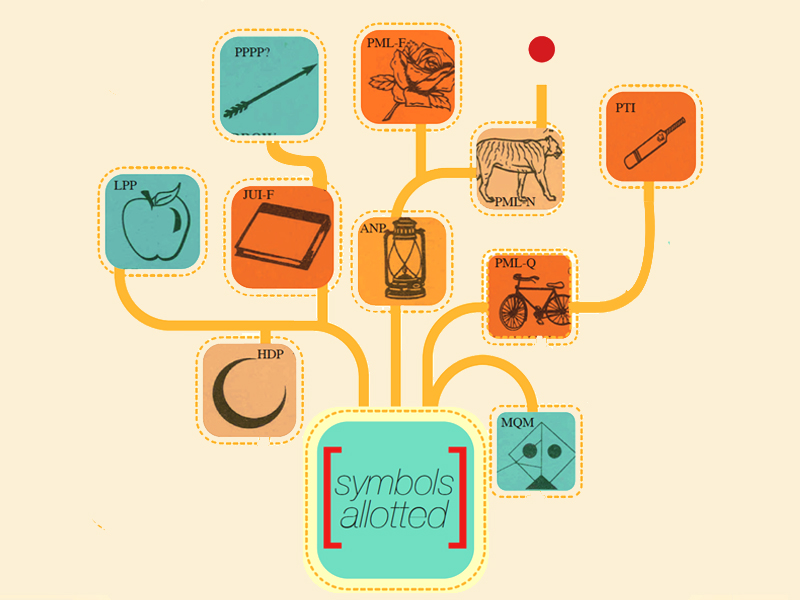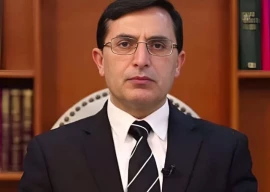
In a much anticipated move, the Election Commission of Pakistan allotted symbols to 144 political parties on Tuesday. The upcoming parliamentary polls will be contested with these emblems. Predictably, the Muttahida Qaumi Movement got its trademark ‘kite’ symbol, while the Pakistan Muslim League-Nawaz latched on to the ‘tiger’. Jamaat-e-Islami won over the ‘scale’ from the Pakistan Tehreek-e-Insaf, which got the ‘bat’.
Dr Abdul Qadeer Khan’s new party Tehreek-e-Tahaffuz-e-Pakistan was allocated the ‘missile’ as its election symbol. The ‘arrow’ has not been allotted to any party yet and the final decision will be made on March 25. Pakistan Peoples Party Parliamentarians is the main aspirant.
Procedure to allocate symbols
According to the Allocation of Symbols Order, 2002, the Election Commission of Pakistan must declare a date for political parties to apply for symbols right after the election schedule is announced. Parties that have fulfilled two main preconditions – the holding of intra-party elections and the filing of party assets – are eligible to receive election symbols. If a political party has been allotted a particular symbol in the past, it is considered its preferential right to get the same one in the next polls, provided application rules have been followed.
Censure and scarcity
Earlier, the commission had fallen short of symbols available, since the number of registered parties outnumbered the available images.
The number of registered parties stood at 227, while only 172 symbols stood approved by the ECP.
These figures stand in jarring contrast to previous years. In past elections, the number of political parties contesting elections stood between 30 and 40.
The commission eliminated various symbols it deemed inferior or insulting, keeping in mind the country’s social context. For instance, certain cultures and subcultures within Pakistan consider the dog, jackal, donkey and owl to hold negative connotations. Similarly, the lota is considered derogatory, colloquially used as a term for turncoats.
In this vein, the lota, banana, ladyfinger, vase, matchbox, bouquet, white radish and Peshawari sandal were eliminated from the list of approved symbols.
However, the ECP also infused new emblems. The missile, computer, mobile phone, watermelon, electrical pole, audio cassette and pushcart were added to the list.
Tug of war
Needless to say, election symbols hold significance for political parties. Each tries to obtain a sign that best illustrates their manifesto and ideology. Given the sensitivity about images, there is unavoidable overlap in demand for certain symbols. In this situation, the ECP had to intervene and rule.
A recent instance of such a tug-of-war was the JI and PTI squabble over the allotment of the Tarazoo (weighing scale). Both parties formally applied to the commission last year to reserve the scale, and made their cases over multiple sittings with ECP officials.
The PTI claimed that the Tarazoo represented their ideology – the movement for justice – best.
With the same vigor, JI emphasised its past use of the symbol and how it depicted the party’s manifesto.
In the end, the scale tipped in JI’s favour as the ECP considered it to hold preferential right to the same symbol it had previously contested polls with.
The commission suggested the ‘torch’ and ‘hill’ to PTI as alternatives, but ultimately, it ended up with the ‘bat’ – a reminder of leader Imran Khan’s contributions as cricket captain, and as a promise of restoration of lost glory.
Similarly, the allocation of the book to Fazlur Rehman’s JUI-F was also tinged with controversy. The ECP gave the party an open book, with alphabets and characters, to emphasise that it is just a ‘normal’ volume. However, JUI-F wanted its old symbol – a closed, clean book – and took the commission to court. If the request is complied with, the JUI-F can declare their symbol to depict a holy book during electioneering. A stay order is currently in place.
“It is ironic that the JUI-F gets the book symbol,” said Dr Shireen Mazari, a spokesperson for PTI.
Additionally, the ruling party’s ‘arrow’ is also somewhat undecided. It will probably be given to Pakistan Peoples Party Parliamentarians (PPPP), on behest of the ruling Pakistan Peoples Party (PPP) which is not registered with the election commission. However, a disgruntled group within the PPP – led by Naheed Khan and Safdar Abbasi – has also applied for the symbol. Due to this, and other initial disputes, the arrow issue is still hanging. A concrete decision will be made though on March 25.
JUI-F’s BOOK
Fazlur Rehman’s JUI-F was going to be allotted an open book by the ECP, with alphabets and characters to emphasise that it is just a ‘normal’ book. But JUI-F has taken the commission to the court, leaving open the question, at least temporarily. The party wants its old election symbol (closed book, so they can campaign with it as a holy book)
JI vs PTI (JI wins)
There was a dispute between JI and PTI over the allotment of scale (Tarazoo) as election symbol.
The commission had suggested “torch” and “hill” as alternate symbols for the PTI. However, the PTI was allotted the symbol of a “bat”.
Published in The Express Tribune, March 20th, 2013.

















COMMENTS
Comments are moderated and generally will be posted if they are on-topic and not abusive.
For more information, please see our Comments FAQ